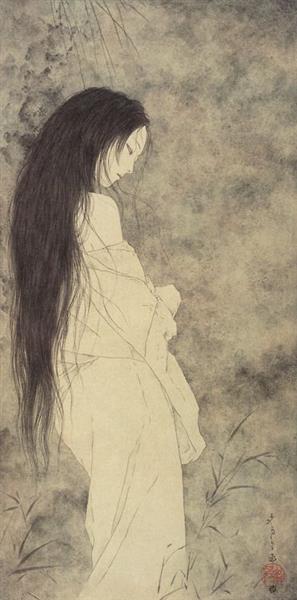I am drawn to Japanese folklore because their yōkai (spirits), far from being simple monsters, are multi-faceted characters. Yuki-onna (‘snow woman’), associated with midwinter and snowstorms, is both terrifying to behold and full of yearning and sorrow.
Legends say Yuki-onna is the spirit of a person who perished in the snow. The ancient stories tell of a huntress, ruthless in tracking and killing unsuspecting innocents. Long black hair, blue lips and almost transparent skin, Yuki-onna is an expert at disguise
amongst the barren woods of her hunting grounds. She either wears a pale kimono - done up in a non-traditional right over left, which is how you can tell she’s not a living woman - or appears naked, leaves no footprints and can turn into a mist or a snow flurry if threatened.
Sometimes she is holding a baby to lure the well-intentioned. Lost and stranded travellers are turned to ice with her frigid breath, their frozen corpses to thaw in spring.
Every prefecture of Japan has its own stories of Yuki-onna. Many are fables to instruct children to use caution, or to warn against eccentricity in childless women, or else to give form to the universal experiences in life and death which may feel as sudden and torrential
as a blizzard, or as insurmountable as a snow drift or permafrost. The stories reflect the misery of rural life, tales of loss and sorrow with gloomy characters like an old childless couple, an exiled hermit or a foolish young hiker.
By a turn of events in their favour these condemned characters are given what they long for, only to have it taken away. In this way Yuki-onna is more a manifestation of cosmic caprice than a murderous creature with big teeth - much more scary.
Yuki-onna sits in the patheon of Japanese winter lore, a time when Gods visit the earth. If one does not pay respects terrible things will happen. Placating these deities is an important part of navigating the coming and going of seasons.
From the 19th century more romantic minds began to cast Yuki-onna as sympathetic; an unfortunate ghost who is bound to the forest alone. Unfortunately her attempts to seek out the company of the living leads only to more death.
Images:
'Ghost Diagram', Takoto Yamamoto, 2006
'Yuki-onna' from the Gazu Hyakki Yakō ('The Illustrated Night Parade of a Hundred Demons') by Toriyama Sekien, 1776.
By @ sceith-A (instagram), 2017
By Uemura Shoen, 1923, held at Fukada Art Museum.
'Ghost Diagram', Takoto Yamamoto, 2006
'Yuki-onna' from the Gazu Hyakki Yakō ('The Illustrated Night Parade of a Hundred Demons') by Toriyama Sekien, 1776.
By @ sceith-A (instagram), 2017
By Uemura Shoen, 1923, held at Fukada Art Museum.

 Read on Twitter
Read on Twitter





